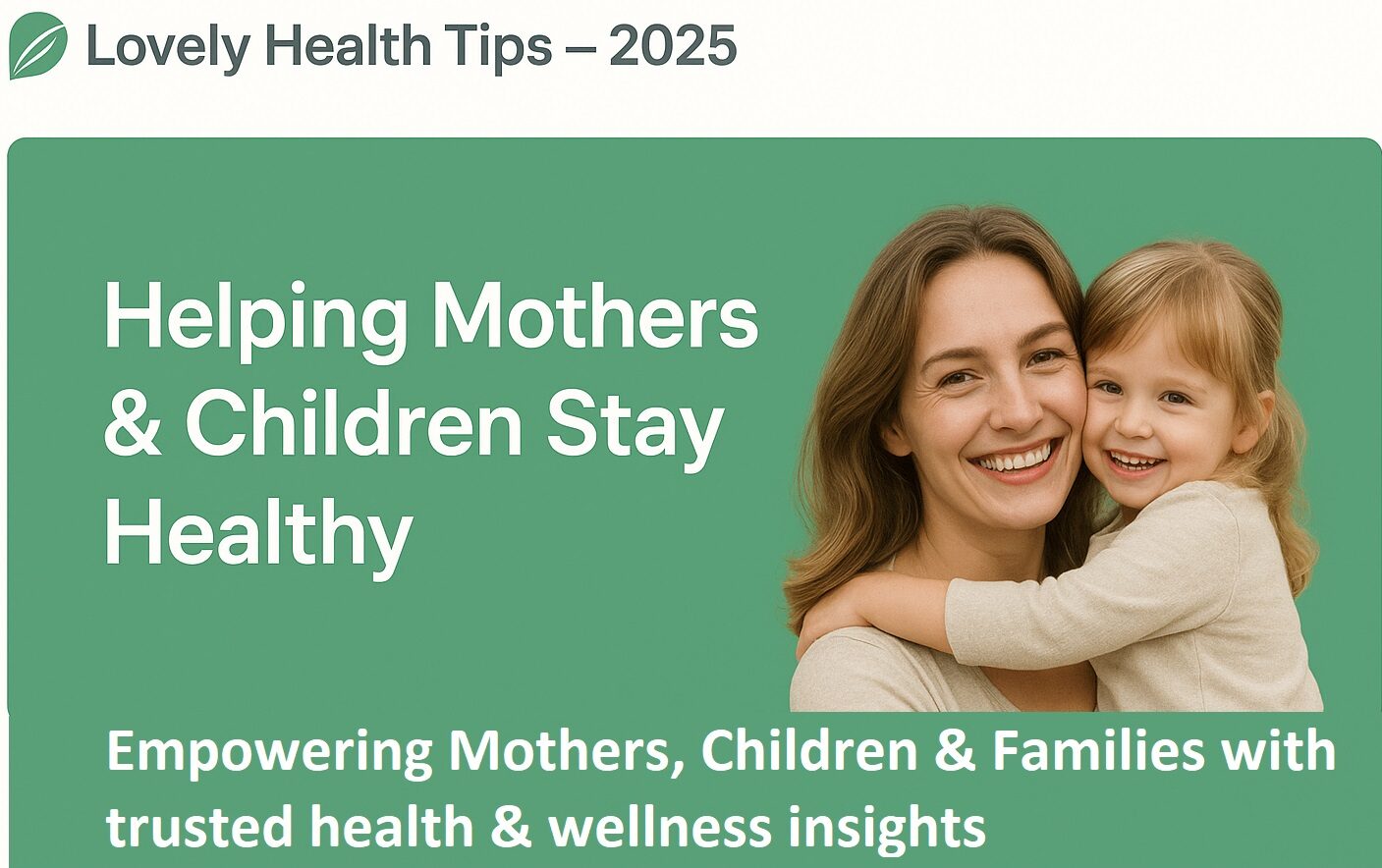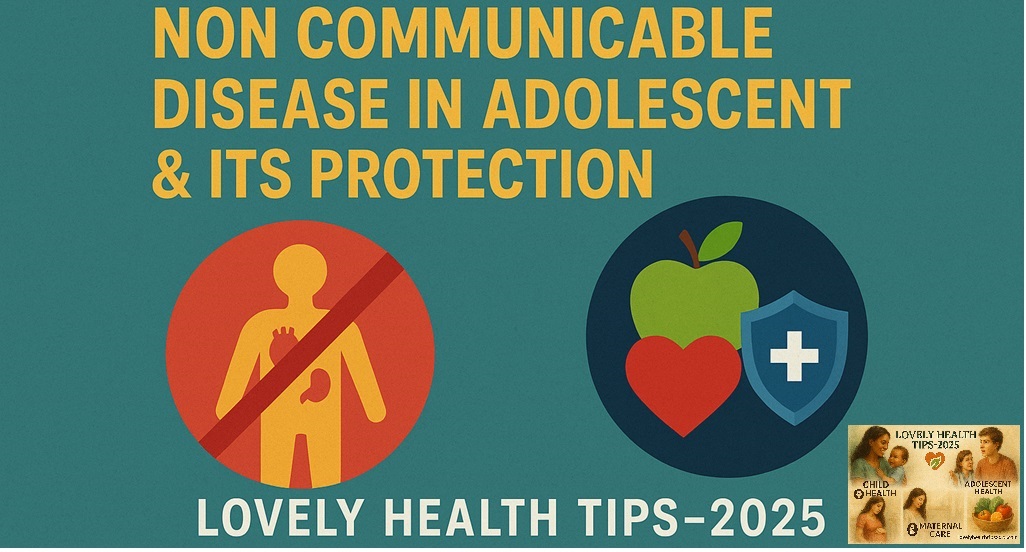Last Updated on October 21, 2025 by
Non Communicable Disease
Reasons of why to pay attention to adolescents:
Most of the cases of non-communicable diseases (NCDs) seen among adolescents, including obesity, diabetes, hypertension and cardiovascular diseases, are generally caused by an unhealthy diet, not exercising enough, feeling stressed, smoking and drinking alcohol. Disorders once thought to only impact adults can now seriously affect the health of children and young people.
Only the prevention of health problems through taking different measures of health promotion is the only way to go, Good nutrition, exercise, mental and psychological health are steps hat will help to move the adolescents into a strong healthy life without any diseases. Helping youth learn to manage their health from a young age can help lower their risk of Non Communicable Diseases.
- Human resource utilization during a stage of great impact.
- This is of significance in the achievement of the nation’s SDG
- Spending on health and wellness of adolescents results in a threefold return.
- The time is right to have exercises into habit-forming ones, and this makes them effective.
- Adhering to the healthy lifestyle during this time will lower the occurrence of NCDs
Many types of risks : Non Communicable Disease in Adolescents :
A. Individual level:
- Lack of enough physical activity
- Very less intake of fruits & vegetables and other veg items
- More likely eating unhealthy foods which are heavy in fat, salt and sugar.
- The use of risky medications including tobacco products and alcohol constitutes dangerous drug utilization
- Maximum vulnerable in Mental stress and psycho-social activities
- Low or high body weight because of nutritional problems
- The general public does not understand the relationship between Non Communicable Disease risk factors which include diet habits exercise patterns and drug abuse patterns
- Inability to avoid tobacco, alcohol
- Diets with unhealthy types
B. Various risks at Family members, community level & school level – Non communicable disease
- Physical activity is negligible in all the situations
- The family eats unhealthy meals and there are plenty of unhealthy food choices everywhere around the house. Various levels of this culture and environment
- Very less or negligible space available for different sports facilities in schools and community
- A high level of stress in the family
- High & more expectations from family members and other educators
- Boys/girls gender discrimination & gender discrimination
C. Apart from Culture and Physical levels, there is also Cultural and Environmental levels.
- Unrealistic promotions of unhealthy dangerous products including alcohol tobacco and low-nutrition foods occur through deceptive marketing methods.
- Political with social in-stability
- Indoor and outdoor pollution
- Spaces that lack safety pose restrictions mainly to women during their movements
- Corporate companies sponsor events to strengthen how teenagers recognize their brand.
- Risk risks associated with lifestyle
- Factor related to Sociodemographic field
Risk Factors in Non Communicable Diseases :
- The main risk factors are smoking, lack of exercise, drug dependence, eating disorders, pollution or stress.
- Prevention, management & control of non-communicable diseases (NCDs) is expensive as they lead to socioeconomic costs.
- The mentioned factors have intensified health burdens among marginalized populations alongside demographic changes, economic development, global trends, and rapid unintended urban growth and the shift from infectious diseases toward chronic diseases.
Typical Signs of Non Communicable Disease in Adolescents
- Cardiac Dieases
- Unable to physically match people of the same age
- Losing air at so much faster than a person of their age
- Being lightheaded as a result of deciding to put on effort
- Palpitations in the heart
- Occasionally, fainting (syncope) and turning blue around the tongue or gums
- Diabetes
- Type-1
- Thirsty and urinating increases
- Hunger
- Fatigue
- Irritability
- Weight loss
- Blurred eyesight
- A fruity odor on the breath
- Girls’ yeast infections DKA
- Diabetic ketoacidosis, can strike some people.
- Type-2
- During night time, may have more frequent urination
- Increased thirst
- Fatigue
- Inexplicable weight loss
- Vaginal itching
- Potentially due to a yeast infection
- Delayed wound or cut healing
- A problem with blurry vision because of dry eyes
- On the extern side of the body, dark and velvety spots called as acanthosis nigricans may appear.
- Type-1
- Cancer
- First appearance of a new skin spot combined with any modifications to its dimensions or shape or complexion.
- Losing weight without trying to
- Sudden changes in your sight or your eyes
- Regular headaches, frequently accompanied with vomiting
- Suddenly a persistent fever/illness of unknown origin
- Unusual bleeding
- Simple bruising
- Tiredness that can’t be explained and a lack of energy
- Asthma
- Coughing frequently that gets worse when you’re lying down or is brought on by chilly air or exercise
- A whistling sound may be heard when you exhale.
- Breathlessness
- Symptoms of Tightness or having congestion in the chest area
- Wheezing, coughing or feeling short of breath can disrupt a person’s sleep.
- Slow recovery after the exhaustion of the lungs
- Mental health
- Depressed
- Learning progress goes down.
- A big change in a person’s appetite
- Issues with sleep
- Socially not active
- Less motivation
- Fear
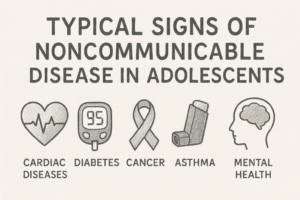
A. Find out what risks are common for adolescents and assess non communicable diseases in them.
- Ensure to conduct a physical examination in history lessons.
- BMI score :
- 18.5-24.9 kg/m2- Normal
- <18.5 kg/m2- Underweight
- 25-29.9 kg/m2- Overweight
- >30 kg/m2- Obese
- Pre-hypertensive >= 120 / 80, but < 95th percentile
- The medical condition of hypertension requires mean blood pressure measurements that stay at or above the 95th percentile regarding height and age together with sex traits when checked on at least three occasions in a month.
B. Awareness among Teenagers for leading Healthy Lives & to Avoid Non communicable disease:
- Lower stress levels together with reducing pollution levels from the indoor environment
- Should increase daily different types of physical activities and having a healthy & balanced diet.
- Eliminate Drug Abuse
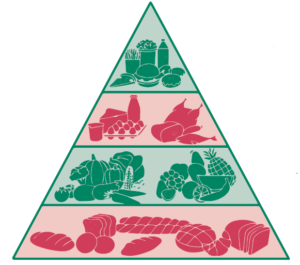
C. Awareness to Adolescent people for Prevention of Non Communicable Disease & Leading a Healthy Lifestyle through more daily Physical Activities
- Explain the positive effects that physical exercise provides to individuals.
- You should concentrate on your current health condition.
- Help teenagers develop a pyramid of their own of the physical exercise.
- Identify the reasons and barriers for those with lack of education in health found solutions.
- Reduce the time spent in front of TV, online/phone games, phones and sitting more than 30 minutes.
- Two to three times per week: Playtime & leisure: singing, playing, swinging Strength and flexibility exercises include boxing, karate, dancing, and push-ups.
- The recommended aerobic workouts along with sports activities should be performed for twenty minutes on a minimum of three to five occasions each week (20 minutes).
- Daily (as much as possible): Play outside, utilize the stairs, assist around the house, walk, bathe your pet, etc.
D. Prevent Non Communicable Disease and Teach Adolescents to Lead Healthy Lives by Preventing Substance Abuse :
- Link’s current health
- Instruct students in the art of refuse.
- Discuss the repercussions.
- Help cut down on use
- Distribute resources
E. Teach Teens to Avoid Non Communicable Disease and Lead a Healthy Lifestyle (Stress) Promote positive and healthful coping mechanisms for stress.
- Different perspectives of adolescents to be recognised.
- Many problem solving techniques may be instructed to the students.
- Refer in the event of severe illness or anguish.
- Encourage self-care for Non Communicable Disease
F. Teach teenagers how to avoid Non Communicable Disease and lead healthy lives by educating them about indoor air pollution.
- Please promote the following:
- Safe and cheap cooking fuels
- Kitchens should have enough airflow and chimneys.
- LPG in subsidized rate may be provided by Govt
- Indoor ventilation
- Always cover both your mouth and your nose while you clean.
- Avoid
- Always smoking from others used items or passive smoking may be avoided
- Laying of water for some time
- A bad or dirty odor is coming from inside the house.e
- Household livestock
G. Encouragement for a Healthy Lifestyle & Prevention of Non Communicable Disease with the support & Working with Families
- Find and overcome anything that is in your way.
- Give information on risk factors, preventive factors, and Non Communicable Disease
- A medical professional must help you with the appropriate care if you have high blood pressure, high cholesterol, high blood sugar or high HbA1c levels.
- Warranty should require yearly check-ups as the minimum requirement.
- Medical assistance should become accessible to families seeking help because they recognize their individual risk aspects.
- The right counseling for adolescents and their parents allows them to cope with bad eating habits, alcohol use, smoking and not enough exercise.
- The adoption of new behavior patterns by all family members creates more successful health habit adoption.
- Depending on your family history, notice any extra risks that may be linked to your genes.
- Family and youth should be motivated to have a healthy diet and do daily exercise
To raise awareness amongst the community about the risk factors for Non Communicable Disease:
- Promoting health community actions
- Take part in helping youth by checking their nutritional health at Adolescent Health & Wellness Days with BMI and hemoglobin estimations.
- Encourage teenagers to get in touch with hospitals to receive advice on what to eat and how to live.
- Involvement of Community people and promotion thereof. Suggest that teenagers reach out to Hospitals to receive nutritional and lifestyle advice.
- Participate in partnerships with groups that already work in the area. So many types of awareness campaigns may be planned supported by trained volunteers.
- Planning of the campaign, special film shows, exhibitions, posters, expert forums, health camps and street plays
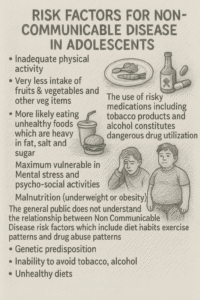
Key points:
- Stress, unhealthy diets, substance abuse, smoking and pollution are the most important risks for NCDs in teenagers.
- NCDS prevention and control are necessary because noncommunicable diseases have socioeconomic effects.
- Most risk factors which present during early life can be modified and prevented with early detection.
- Teenagers need instruction about how physical exercise functions as a disease prevention method for noncommunicable diseases.
- Teach adolescents to cut down substance use while showing them refusal techniques coupled with substance abuse danger awareness lessons.
- Economic growth, fast and unexpected city growth, a switch from infectious diseases to chronic illnesses and changes in population are the main reasons for NCDs in adolescents.
FAQs:
Q1. NCDs stands for?
Ans. You cannot get these diseases from touching, breathing or being with someone in a casual way. These diseases emerge either due to genetic conditions or life choices or external environmental elements. Familiar Non-Communicable Diseases found in patients include diabetes, hypertension, obesity, asthma and mental health disorders.
Q2. The high level of NCD risk in adolescents depends on which factors?
Ans. Adolescents face two periods of NCD development risk because they adopt habits such as unhealthy eating and inactivity alongside smoking and stress during their teenage years.
Q3. What are the top NCDs that oppress adolescent populations?
Ans. The most prevalent new Non-Communicable Diseases affecting teens include the following disorders:
- Childhood obesity
- Type 2 diabetes
- Hypertension i.e high blood pressure
- Asthma Depression and anxiety
- Early signs of heart disease
Q4. What are the steps that should be taken to prevent NCDs by young people?
Ans. As below:
- Fruit, vegetables along with coarse grains form the most important defense in adolescents.
- Physical exercises may be 30 minutes per day
- Adolescents should stay away from tobacco products together with alcohol and select junk food consumption
- Medical examinations regularly
- The stress can be the stress that can be managed through mindfulness exercise and activities and counseling.
Q5. How important may be early intervention to control Non Communicable disease?
Ans. Adolescent-developed life patterns usually persist during adulthood. When people make lifestyle changes during their early years they can decrease the development of 80% of heart disease and stroke and diabetes that occur early.
Q6. Does Schools and parents jointly assume vital positions when facing this question?
Ans. Parents need to display good health practices while promoting honest dialogue between their children.
Q7. Is Mental health disorders fulfill all criteria to be classified as non-communicable diseases?
Ans. Recent studies demonstrate that adolescent depression and anxiety symptoms exhibit a very high rate of increase as these diseases are regarded as non-communicable morbidities. Getting an early diagnosis together with necessary support stands as a fundamental requirement.
Q8. Parents should be alert for which specific indicators to detect in their teenagers.
Ans. As below:
- Changes in your weight
- Many people react to trauma with sadness or having mood swings.
- During some activity, Shortness of breath may occur
- Having repeated problems with headaches or fatigue.
Q9. Final tip for adolescents?
Ans. You will be glad you have taken care of yourself in the future.
Guideline of WHO for Non communicable disease and its link as mentioned below: https://www.who.int/news-room/fact-sheets/detail/noncommunicable-diseases
Thanks and Regards
About the Author – “Mr. Bibhu Ranjan Mund”, Master in Public Health (MPH) from IIHMR University, Jaipur (Rajasthan) has experience of 18 years in Public Health activities. Through “Lovely Health Tips-2025”, we share the evidence & experienced based health & wellness guides with solutions for every day well-being. More from Author
Disclaimer
This information is suggestive only and not a replacement for medical advice. For more detail, please visit to my website as mentioned below:
